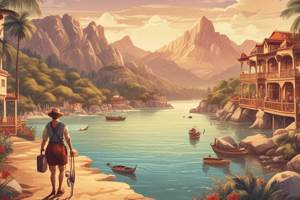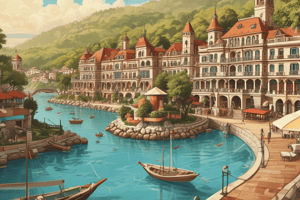Podcast
Questions and Answers
What is the primary goal of destination marketing?
What is the primary goal of destination marketing?
- To promote a destination's individual and/or collective experiences to targeted visitors (correct)
- To increase the revenue of local businesses
- To create a unique brand identity for a destination
- To attract as many tourists as possible to a destination
What type of tourist is most likely to prefer package tours and known brands?
What type of tourist is most likely to prefer package tours and known brands?
- Mid-centric tourist
- Adventure-seeker
- Independent traveller
- Psychocentric tourist (correct)
What is the key aspect of tourism marketing, according to the American Marketing Association?
What is the key aspect of tourism marketing, according to the American Marketing Association?
- Co-creating and delivering value for producers and consumers (correct)
- Designing and promoting tourism destinations
- Creating and delivering tourism experiences
- Communicating and exchanging offerings of value
What is the primary focus of tourism marketing campaigns?
What is the primary focus of tourism marketing campaigns?
What is the ultimate goal of tourism marketing, beyond just attracting tourists?
What is the ultimate goal of tourism marketing, beyond just attracting tourists?
What type of tourist is most likely to engage in self-organised activities?
What type of tourist is most likely to engage in self-organised activities?
What is the key factor in creating a high-value tourism experience?
What is the key factor in creating a high-value tourism experience?
What is the primary motivation of Allocentric tourists according to PLOG's typology?
What is the primary motivation of Allocentric tourists according to PLOG's typology?
According to the UN World Tourism Organization, what is the maximum duration of stay for a person to be considered a tourist?
According to the UN World Tourism Organization, what is the maximum duration of stay for a person to be considered a tourist?
What is a key difference between domestic and international tourism marketing?
What is a key difference between domestic and international tourism marketing?
What is a 'push' factor in tourism?
What is a 'push' factor in tourism?
What is the term for a non-resident visitor who travels to and within a country of reference?
What is the term for a non-resident visitor who travels to and within a country of reference?
What is the term for the combination of inbound and outbound tourism?
What is the term for the combination of inbound and outbound tourism?
What is a key characteristic of domestic tourism marketing?
What is a key characteristic of domestic tourism marketing?
What is the primary objective of Destination Marketing Organisations (DMOs)?
What is the primary objective of Destination Marketing Organisations (DMOs)?
What is the key characteristic of destination image?
What is the key characteristic of destination image?
What is the primary marketing tool used by Tourism New Zealand to promote New Zealand as a tourist destination?
What is the primary marketing tool used by Tourism New Zealand to promote New Zealand as a tourist destination?
What is a characteristic of 'high-value' tourism?
What is a characteristic of 'high-value' tourism?
What is a key aspect of the tourist journey?
What is a key aspect of the tourist journey?
What is the primary goal of Tourism New Zealand's marketing efforts?
What is the primary goal of Tourism New Zealand's marketing efforts?
What is a characteristic of tourism products?
What is a characteristic of tourism products?
What motivated visitors to visit the pyramids in 2700 BC?
What motivated visitors to visit the pyramids in 2700 BC?
Which of the following contributed to the growth of tourism in England?
Which of the following contributed to the growth of tourism in England?
Who organized the 18th Century Grand Tour?
Who organized the 18th Century Grand Tour?
What was the primary motivation for tourists to visit the Holy Land during the 14th century?
What was the primary motivation for tourists to visit the Holy Land during the 14th century?
Which of the following was a result of the industrial revolution?
Which of the following was a result of the industrial revolution?
What led to the development of resorts outside major urban centers?
What led to the development of resorts outside major urban centers?
What was the primary motivation for affluent Europeans to travel during the 18th century?
What was the primary motivation for affluent Europeans to travel during the 18th century?
Which of the following influenced the modern travel industry?
Which of the following influenced the modern travel industry?
What was the result of the upper class leading the trend of 'salt water dipping' in Brighton?
What was the result of the upper class leading the trend of 'salt water dipping' in Brighton?
Flashcards are hidden until you start studying
Study Notes
Types of Tourists
- Independent Travellers: love exploring and trying new experiences
- Mid-Centric Tourists: enjoy adventure but also like the comfort of home, may combine pre-booked and self-organised activities
- Psychocentric Tourists: prefer familiarity, give preference to known brands, and enjoy package tours and regular stays at resorts
Tourism Marketing
- Defined as the activity, set of institutions and processes for creating, communicating, delivering and exchanging offerings that have value for customers, clients, partners, and society at large
- Involves the co-creation and exchange of value for producers and consumers through design and delivery of tourism experiences
Destination Marketing
- Means by which destinations promote their individual and/or collective experiences to visitors
- Destination marketing organisations (DMOs) promote a destination to visitors
- Destination image: the sum of beliefs, ideas, and impressions that a person has of a destination, which is subjective and individual, and a key market metric that defines tourist behaviour
Tourism New Zealand
- Organisation responsible for marketing New Zealand to the world as a tourist destination
- Uses the 100% Pure New Zealand marketing campaign, which has evolved over 20+ years to make NZ one of the world's most well-respected tourism brands
Nature of Tourism Products and the Tourist Journey
- Intangible
- Role of people
- Variable service
- Perishability and seasonality
- Social contexts (shared experience)
"High Value" Tourism
- Defined by Minister of Tourism Stuart Nash as high-value, high-quality visitors who give back more than they take, travel across seasons and regions, are environmentally conscious, and seek to offset carbon emissions
- High-value tourists are respectful of local communities and cultures, appreciate the efforts of the local workforce, and want to learn about local history and culture
Development of Tourism
- Coincides with technological advancements
- Has undergone significant changes pre-pandemic and post-pandemic
Definition of Tourism
- Temporary movement of people to destinations outside their normal places of work and residence, including activities undertaken during their stay and facilities created to cater to these needs
- Comprises the activities of persons traveling to and staying in places outside their usual environment for not more than one consecutive year for leisure, business, and other purposes
Overview of the Tourism System
- Complex system made up of several systems, within a larger system
- Components include:
- Geographic regions
- Macro-environment
- Tourists
- Travel and tourism industry and its sectors
Components of the Travel and Tourism Industry
- Transportation
- Accommodation (+ food and beverage - hospo)
- Attractions
- Events and festivals
- Amenities and infrastructure
- Administration - government ministries relevant
- Marketing and promotion
Classification of Tourists (UNWTO)
- Domestic tourist: individual who travels within their country of residence
- Inbound tourist: non-resident visitor who travels to and within a country of reference (destination country)
- Outbound tourist: resident visitor who travels outside of their usual country of residence
- International tourism: combination of inbound and outbound tourism
Differences between Domestic and International Tourism
- Domestic tourism:
- Travellers are familiar with the country
- Lower marketing costs
- Traveller needs are consistent across segments
- Simpler, shorter itineraries
- Often no language or cultural barriers
- Easy market to enter and return on investment established more quickly
- Distribution system is consistent and operators deal with consumers directly
- International tourism:
- Traveller may have limited knowledge of the country
- Higher marketing costs
- Traveller needs vary in each market and segment
- Complex itineraries
- Language and cultural differences
- Long-term investment to recoup costs
- Distribution systems vary in each market
Why do Individuals Travel?
- Push factors:
- Personal inherent motivations
- Burnout, needs to relax, see new things - novelty
- Escape, relaxation, novelty, knowledge-seeking, socialisation
- Pull factors:
- Fulfill needs of push factors
- Attractions, activities, climate, culture, safety and security, entertainment
PLOG's Typology of Tourists
- Allocentric tourists (venturers): not afraid of the unknown
History of Tourism
- Egyptians: started building pyramids in 2700 BC, attracted large numbers of visitors then and now, with a prime motivation of curiosity or novelty
- Greeks: honoured Zeus by athletics (Olympics)
- Phoenicians: carried paying passengers around the Mediterranean
- Chinese (Qing dynasty): paid homage to gods and goddesses through sacred sites
The Beginnings of Tourism Marketing
- Egyptians: started building pyramids in 2700 BC, attracted large numbers of visitors then and now, with a prime motivation of curiosity or novelty
- Greeks: honoured Zeus by athletics (Olympics)
- Phoenicians: carried paying passengers around the Mediterranean
- Chinese (Qing dynasty): paid homage to gods and goddesses through sacred sites
Foundation of the Modern Tourism Industry
- Religion: influenced the modern travel industry, e.g. pilgrimage to Mecca for Muslims
- Health and Wellbeing: growth in tourism to seaside resorts in England, e.g. 'salt water dipping' rather than swimming became popular in Brighton, England
- New dimensions and developments: affluent Europeans travelled to view romantic and fascinating scenery and landscapes, and to learn about history, architecture, literature, and antiquities
What does this History Tell us About Tourism Today?
- Nothing is specified in the text.
Studying That Suits You
Use AI to generate personalized quizzes and flashcards to suit your learning preferences.




